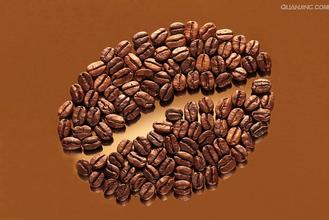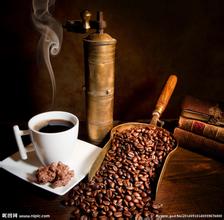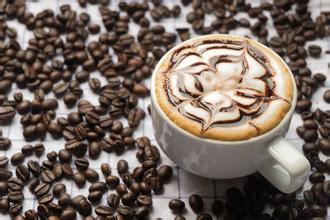The correct way to beat the coffee pressed powder
Coffee beans
Milk is refrigerated in the refrigerator at a temperature of about 4 degrees: it is easy to preserve quality, the milk temperature for iced coffee and the milk temperature for hot coffee are usually 65 degrees and 70 degrees, so the lower the temperature of the milk is, the longer it can be heated, and the milk bubbles are more and finer.
Iced coffee with ice milk bubble, the tool is the milk bubble tank, the milk level should be high and filter a certain height, hit it. Dense holes blow out dense bubbles.
Hot coffee with hot milk foam, 65 to 70 degrees, espresso is 85 to 90 degrees, mixed is about 65 degrees, served in front of guests is more than 60 degrees, the entrance is neither hot nor cold, known as hot coffee.
It has been explained that the principle is because the fat content is higher than 3%, and then changes when heated to form milk bubbles and so on. I used to do well in chemistry and physics, but now the remaining memory fragments can't make me make a "solution:"... "
The day before yesterday, the store ran out of milk, so I forgot to order it, so I had to ride to the supermarket to buy it, so I bought a bottle of "President" skim milk by the way. When I came back, I beat it with steam twice, and it can make milk foam. I remember someone once said that skimmed milk bubbles can also be used to make foam. It is also said that milk bubbles change the properties of protein when heated. Hey, what about the bubble jar? it's not heated? How do you explain it? Everyone has played with soapy water and ate bubbles. I think the principle is the same. What is the surface tension, soapy water is too light to blow long-lasting bubbles, milk? There are few "sticky" ingredients, and there are no lasting bubbles. Many of the milk on the market is too light (impure, add water). You can see from the price that Nestl é milk is neither high nor low, nor pure, but with some thickeners and stabilizers, it has a similar effect to washing powder, right?
Ha ha, look at the people put up with me for a long time, I this nonsense is really a lot of ah, in fact, no matter what the principle of that, hit the foam on it. The key to beating milk foam is "fine air". When the milk is good, it is easy to hit, because you can first blow out a bigger milk bubble and then cut it with steam until it is very small and delicate. In fact, those who have used the bubble tank all know that the fight is very delicate, why? Because the small hole in that metal filter is fine enough. The "personal feeling" rotation method is better. The tilt angle of the steam rod, the height of the milk and the angle of the steam blown out of the steam nozzle should be matched well, so that the steam enters the liquid surface at about 45 degrees (not calculated accurately) and does not rush to the bottom of the cylinder (which will affect rotation). The steam should not be too small (rotate slowly, the gas brought in is not fine or fast) nor too large (heating too fast, spinning too fast) the steam nozzle is near the liquid level. Make the water vapor bring enough fine gas into the milk to form milk bubbles. The finer the sound, the smaller the gas brought in by the steam, and the better the effect of the foam. The amount of milk should be enough, or the heating time is too short and it will not be able to form a stable rotation, but do not pull the flower jar too much. Hit as much as you use, and pay attention to economy.

Important Notice :
前街咖啡 FrontStreet Coffee has moved to new addredd:
FrontStreet Coffee Address: 315,Donghua East Road,GuangZhou
Tel:020 38364473
- Prev

Coffee roaster exhaust roasting technology Italian espresso
Coffee roaster exhaust roasting technology Italian espresso 1, Germany's probat coffee bean roaster old brand, large and medium-sized machines, semi-automatic, automatic various types are complete, sophisticated design, expensive. 2. Japan fuji-royal coffee bean roaster Japan fuji coffee bean roaster, the performance is also good, but the same price is not cheap choice of inner pot material
- Next

Why coffee beans at high altitude are good-description of the flavor of coffee beans at low altitude
Why coffee beans at high altitude are good-the flavor of coffee beans at low altitude describes the lower the temperature, causing coffee to grow more slowly at higher elevations, and because the growing period is longer, coffee trees absorb more salt from the soil. the fuller and bigger the coffee fruit, the harder the beans, and the taste is naturally richer and sweeter. In addition, in areas with low temperatures, the leaves of coffee trees
Related
- What brand of black coffee is the most authentic and delicious? what are the characteristics of the flavor of the authentic Rose Summer Black Coffee?
- Introduction to the principle and characteristics of the correct use of mocha pot A detailed course of mocha pot brewing coffee is described in five steps.
- Which is better, decaf or regular coffee? how is decaf made?
- How much is a bag of four cat coffee?
- How about four Cat Coffee or Nestle Coffee? why is it a cheap scam?
- Which is better, Yunnan four Cats Coffee or Nestle Coffee? How about cat coffee? is it a fake scam? why is it so cheap?
- How about Cat Coffee? what grade is a hoax? which instant coffee tastes better, four Cat Coffee, Nestle Coffee or G7 coffee?
- Process flow chart of coffee making-Starbucks coffee making process what coffee tastes good at Starbucks
- The top ten best coffee beans in the world Rose summer coffee or Tanzanian coffee tastes good
- Yunnan four cat coffee is good to drink?_four cat coffee is a big brand? four cat blue mountain coffee is fake?

